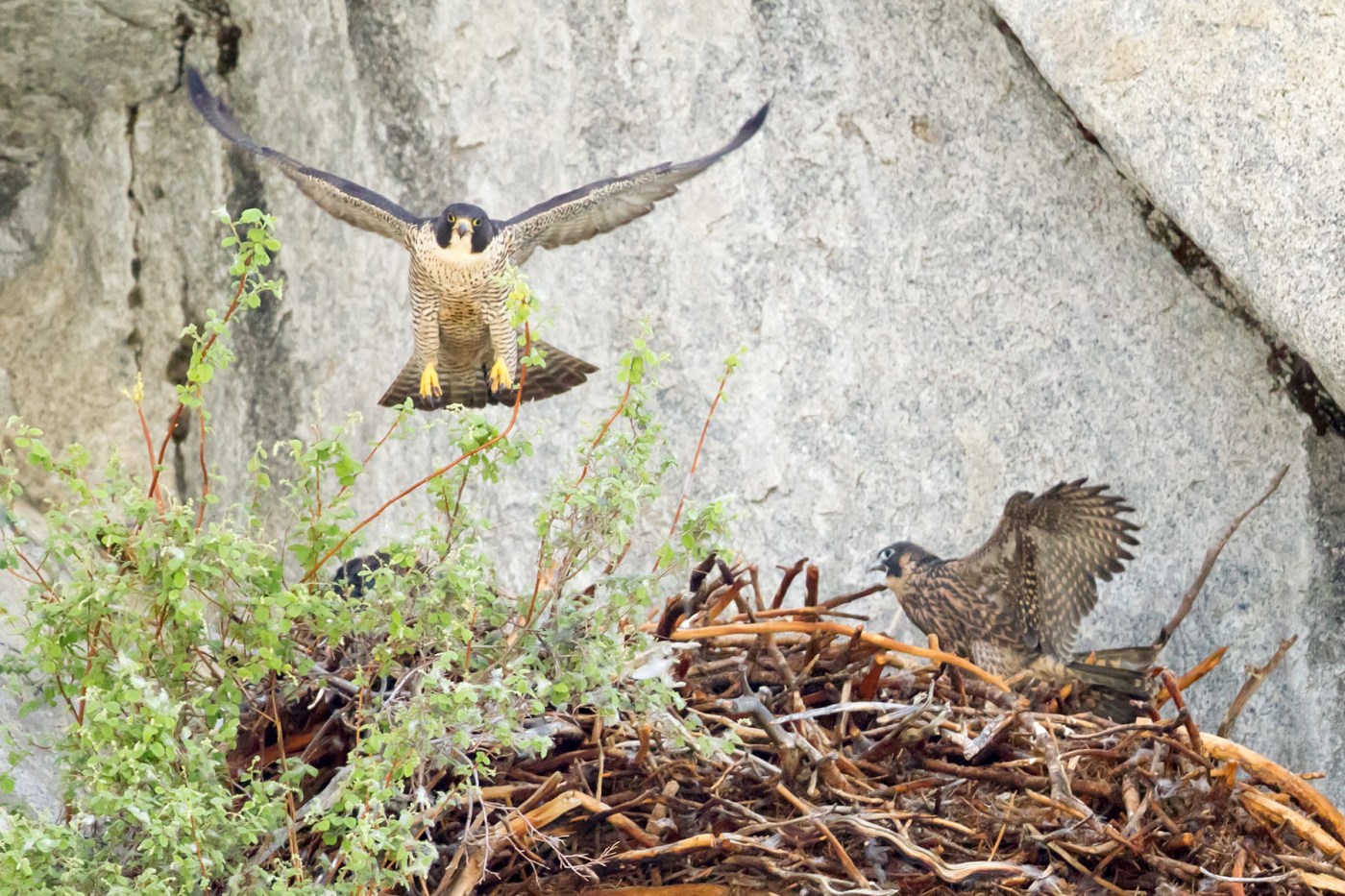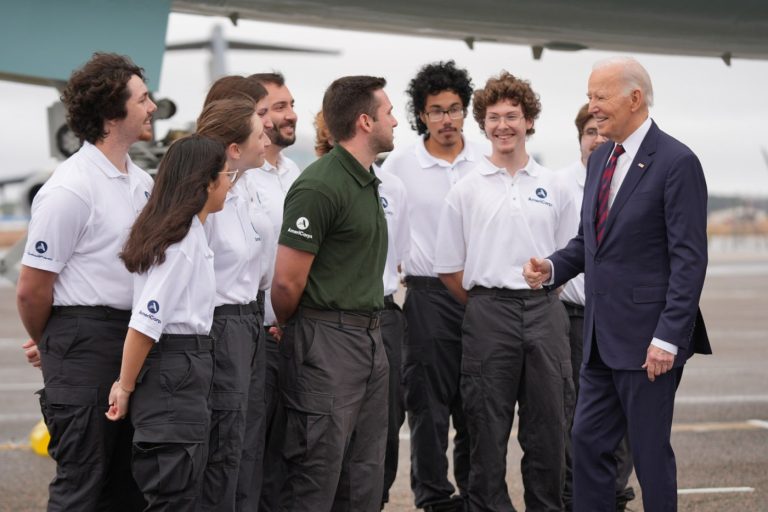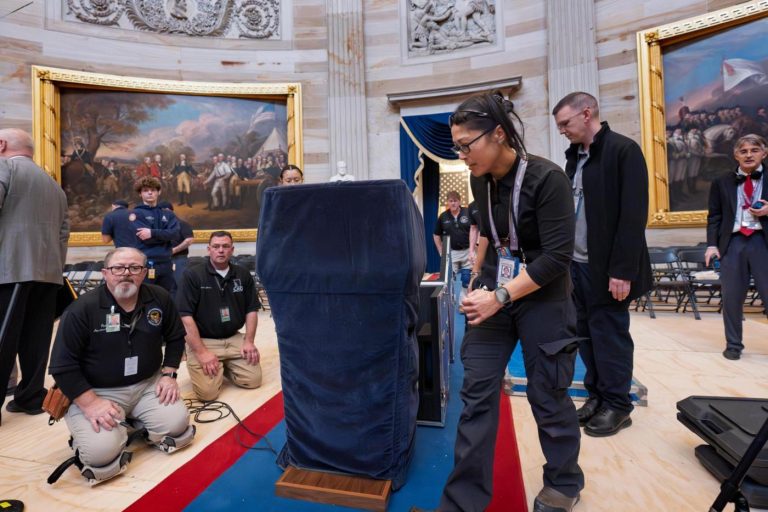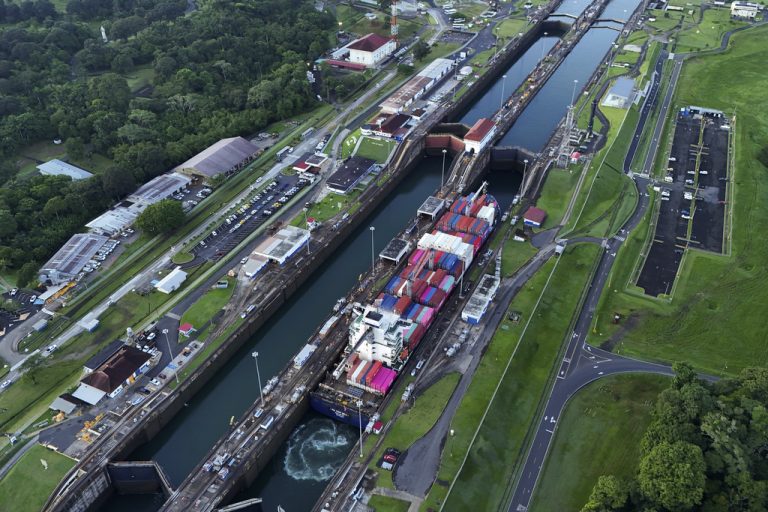Four decades ago, as they were dive-bombed by a pair of peregrines, a small team of expert climbers saved a nest of fragile falcon eggs from Yosemite’s El Capitan sheer granite wall.
Those rare eggs hatched a new generation of baby birds, then another, a testament to one of the most successful conservation stories in California history — and proof of the power of human partnerships to protect a species that was once on the brink of extinction.
The number of breeding pairs of peregrine falcons, the world’s fastest animal, has doubled during a 15-year-long collaborative recovery plan involving climbers, the National Park Service and Yosemite Conservancy, the park announced on Wednesday.
This spring, there were 17 breeding pairs in the park, up from only eight pairs in 2009. A total of 51 nesting sites have been counted since 2009, yielding 385 baby birds.
“It feels wonderful,” said long-ago rescuer Ken Yager, now 65 and living in Mariposa. “I thought that the project had a very slim chance of working. I am glad I was wrong.”
On the Yosemite Falls Trail, hikers read a sign about climbing closures to protect nesting peregrine falcons.
The relationship between rock climbers and the cliff-dwelling birds could have been a fraught one.
Majestic birds, peregrine falcons choose cliffs for their nesting sites because the sheer walls protect chicks from terrestrial predators. The high altitude allows the birds to spot potential threats as they approach from below. Their dive speeds can exceed 200 miles per hour.
But the presence of rock climbers can scare birds away from their nesting sites, leaving their young unprotected from predators, according to research. An assessment by the International Union for Conservation of Nature, the leading information source on the global extinction risk status of animals, lists rock climbing as a threat to the species.
Yosemite’s Peregrine Falcon Protection Program protects the birds by temporarily closing off some climbing routes. In its early years, it enlisted rock climbers as a valuable resource for the bird conservation project, traversing hard-to-access habitats.
“By avoiding off-limits areas and educating fellow adventurers, climbers help ensure falcon fledglings have the best chance of survival,” said Jesse McGahey, a Yosemite park ranger.
Before the mid-20th century, there were more than 3,800 adult peregrine pairs in the United States. But by 1974, only 324 pairs remained in the U.S., killed off largely by widespread use of the synthetic insecticide DDT. An accumulation of DDT in birds caused them to lay eggs with very thin shells that easily broke.
Peregrines were declared a federally endangered species in 1970, and they were added to the California endangered species list the following year. DDT was outlawed in the U.S. in 1972.
In Yosemite, the birds vanished. The last pair was spotted in 1941 on Mount Broderick, above the Mist Trail.
In 1978, climbers Dale Bard, Hugh Burton, Bruce Hawkins and Ron Kauk were startled to discover an active nest while ascending “New Jersey Turnpike” on the southeast face of El Capitan, a 3,000-foot-high granite monolith that looms above the valley floor, according to Yager.
This spurred a recovery effort.
The Santa Cruz Predatory Bird Research Group hired climbers to gather egg shell samples from the nest ledges for testing. Then the group launched a bold plan: take the thin-walled eggs from nests, incubate and hatch them in the safety of a laboratory, and return the young to the nests.
Yager and his group ascended to a second nest on the left of an 80-foot Ponderosa pine and removed the eggs. The eggs were placed in foam-protected containers and passed from climber to climber — “like a fire brigade,” said Yager — to a backpack. Then a lab-hatched chick, carried in a small blue fabric cage during the climb, was gently placed in the nest.
“I was terrified,” he recalled. Overhead, “the peregrines would sort of stall out, flying upward about 150 to 200 feet. When they lost their airspeed, they would do a wingover and tuck their wings in and drop like a rock.”
“Just when I thought I was going to die, they would flare their wings above my neck and glide off, just inches from me,” so close that Yager could feel the breeze. Fellow climber Rob Roy Ramey, who was supervising the process, was hit on his pack. But he didn’t fall.
Carrying the eggs, the climbers rappelled down. Within a half hour, the adult birds returned to the nest, feeding their new baby.
With climbers’ help, these captive breeding programs successfully released over 1,000 young peregrines back into the wild. Peregrines are versatile enough to nest in cities, but national parks are intended to conserve the birds’ natural ecosystems.
Now the Peregrine Falcon Protection Program, started 15 years ago by wildlife biologist Jeff Maurer and supported by donors and a large gift from Maurer’s family after his death, protects the peregrines through targeted closures of climbing areas.
“Yosemite’s successful strategy stands out for its focus on balancing falcon management and visitor recreation. While Yosemite’s walls and domes offer ideal habitat for the raptor, that rocky habitat also makes the park a coveted climbing destination,” said Frank Dean, president of the Yosemite Conservancy.
A Yosemite researcher uses a telescope to observe peregrine falcons on a cliff in Yosemite Valley
Rather than issuing indiscriminate route closures, Yosemite implemented a plan based on routine monitoring of dozens of cliff sites. Buffer zones above the cliffs prevent helicopters from flying unnecessarily close.
The park imposes, adjusts or lifts closures based on each peregrine family’s activity. No more than 5% of climbing routes are closed at a time, starting in March. Once the fledglings have left their nests in mid-July, the routes are re-opened.
This year, for instance, the park closed routes on Higher Cathedral Rock between and including “Power Point” and “The North Face,” routes on The Rostrum in Lower Merced Canyon, and parts of the southwest face of El Capitan, between and including the routes “Octopussy” and “Dihedral Wall.”
Elsewhere around the nation, about 85 to 100 climbing areas nationwide are closed to protect falcons, as well as golden eagles, during their nesting period.
“Without help, peregrines probably would have disappeared from the park,” said Yager, who still climbs almost daily. “I am proud that I was able to have a small part in their future survival.”











